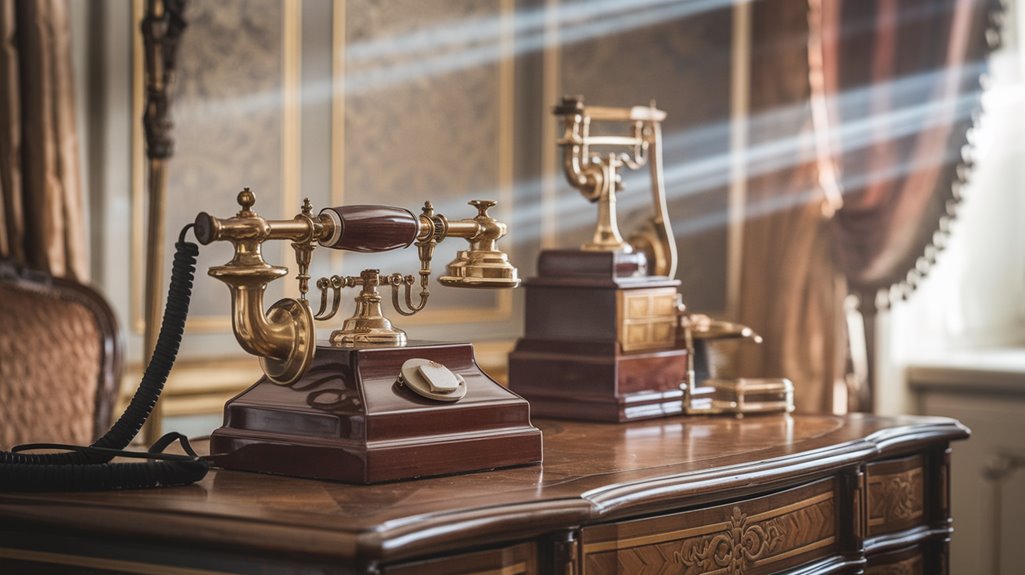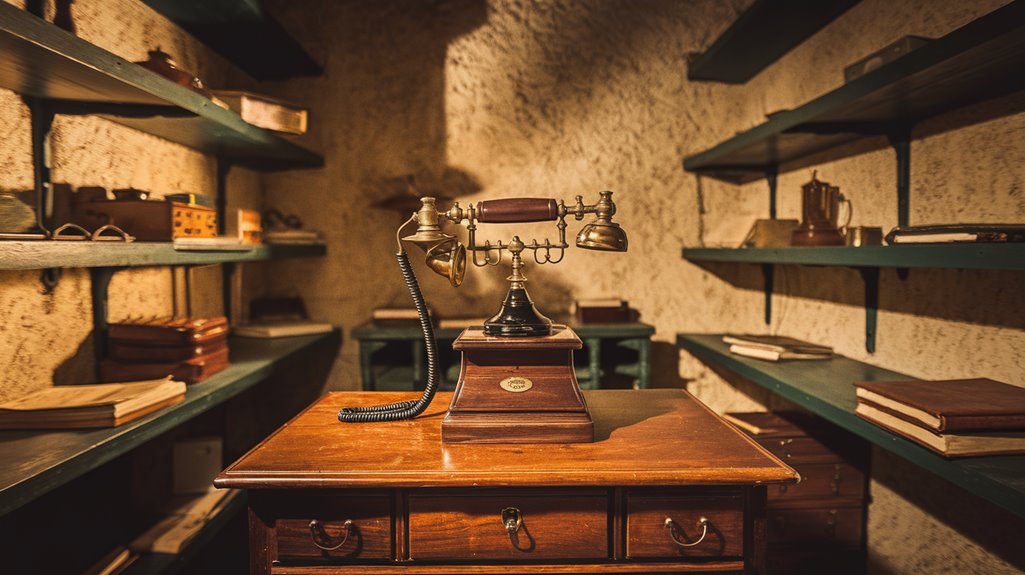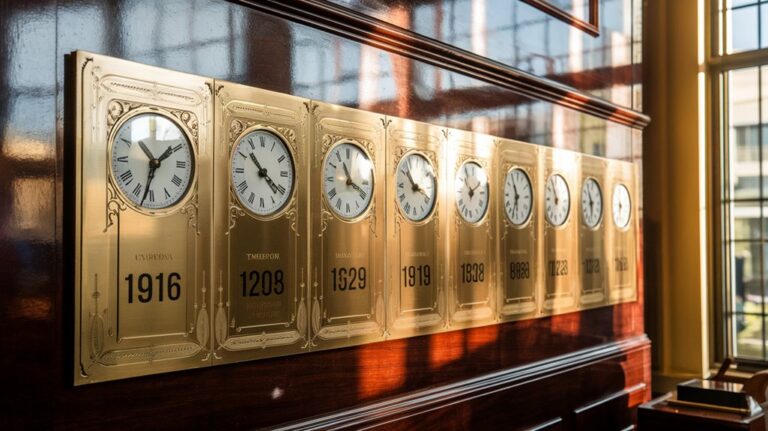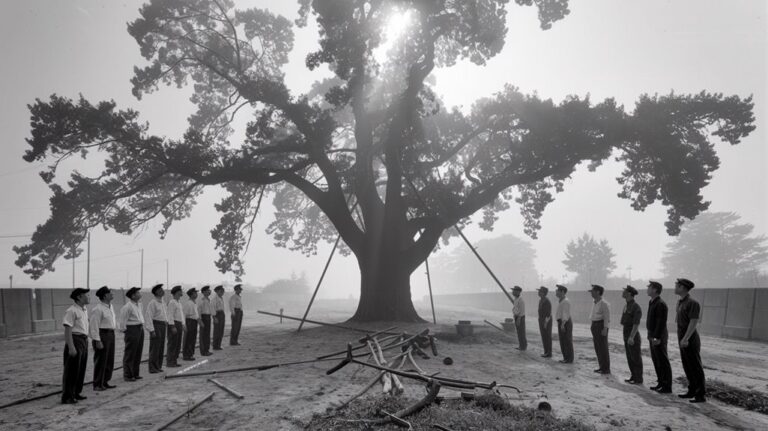The First Phone Call’s Words Were “Mr. Watson, Come Here
Just as you might call for help when you spill something, Alexander Graham Bell's first telephone call came from an actual accident – spilled battery acid. You've probably heard the famous words "Mr. Watson, come here" countless times, but there's more to this story than just a simple request for assistance. The real circumstances behind that historic moment, and what happened in the seconds after Watson heard those words, reveal a fascinating tale of innovation and human connection.
The Historic Moment in Bell's Laboratory
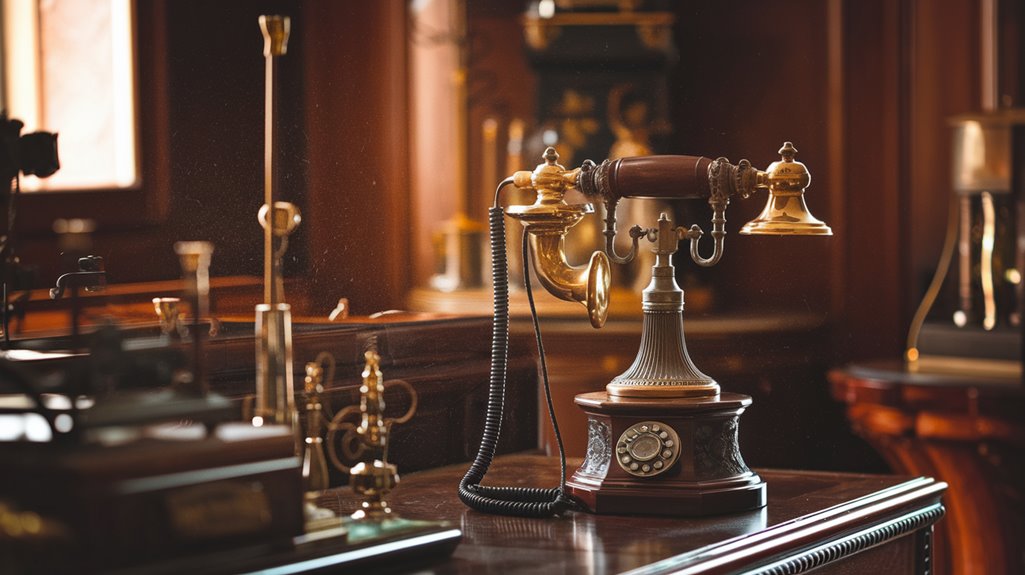
On March 10, 1876, Alexander Graham Bell made history when he successfully completed the world's first telephone call to his assistant Thomas Watson.
You might be amazed to learn that this groundbreaking telephone innovation occurred in Bell's laboratory, where the two men were in different rooms of the same building.
Bell shouted into the transmitting instrument, "Mr. Watson, come here, I want to see you," marking a defining communication breakthrough.
The experiment's success wasn't just luck – Bell had received his patent just three days earlier.
While the initial sound was muffled, Watson clearly understood the message and confirmed it by repeating the words back.
Born in Edinburgh, Scotland, Bell had dedicated his entire life to studying sound and communication before this momentous achievement.
This remarkable achievement proved the telephone's technical feasibility and laid the foundation for modern telecommunications, forever changing how you communicate.
His profound dedication to communication was shaped by his role as a teacher of the deaf, which influenced much of his early work and research.
Setting the Stage: Boston's 5 Exeter Place
The historic site at 5 Exeter Place in Boston stands as a tribute to Bell's revolutionary breakthrough in telecommunications.
You'll find this significant location near where Bell first transmitted an intelligible voice over electric wire on March 10, 1876. The site's importance in telecommunications history is marked by a plaque installed in 1916 by The Bostonian Society and New England Telephone and Telegraph Company.
While Bell's original laboratory was located on Court Street's fifth floor, you can now visit the reconstructed workspace in the Verizon Building at Post Office Square. Those famous first words "Mr. Watson, come here" marked the birth of telephone communication. Just blocks away, the Parker House hotel became renowned for its culinary innovations after opening in 1856.
There, you'll discover his workbench, tools, and patent models, including the world's first commercial telephone and switchboard. The Institute of Electrical and Electronics Engineers has recognized this achievement as a milestone in electrical engineering.
Bell and Watson: The Minds Behind the Call
Behind every groundbreaking invention stands the partnership of brilliant minds, and Alexander Graham Bell's telephone emerged from his remarkable collaboration with Thomas A. Watson.
You'll find that Watson, who began his career at 14 in a Boston electrical shop, became Bell's perfect complement in their telephone invention journey.
Bell's family background in speech and teaching the deaf merged perfectly with Watson's hands-on electrical expertise. Their collaboration dynamics proved invaluable – while Bell conceptualized, Watson crafted the practical components, contributing over 35 patents to their shared vision. Watson's dedication led him to become the head of research at Bell Telephone Company in 1877.
After leaving Bell in 1881, Watson ventured into shipbuilding and established the successful Fore River Ship and Engine Building Company.
Together, they achieved the unthinkable on March 10, 1876, when Bell's words "Mr. Watson, come here, I want to see you" traveled through their device, marking the first successful telephone call in history.
From Patent to Reality: A Three-Day Timeline
During a pivotal three-day period in March 1876, Alexander Graham Bell's telephone journey transformed from concept to reality.
You'll find it fascinating that while patent challenges and invention disputes would later emerge, these three days marked a historic milestone in telecommunications history. The telephone's revolutionary design included a transmitter and receiver working together to enable voice communication.
- Bell submitted his telephone patent on March 3rd
- The patent office processed his application over the weekend
- He received U.S. Patent No. 174,465 on March 7th
- The approval came on Bell's 29th birthday
- The patent would later face over 600 legal challenges
Despite future claims from inventors like Antonio Meucci, who'd developed his "teletrofono" earlier, Bell's patent submission and quick approval proved essential.
This patent, which courts would repeatedly uphold through numerous invention disputes, laid the groundwork for one of humanity's most transformative devices. The telephone's impact would continue to grow exponentially, with over a billion people transitioning to wireless communications by the year 2000.
How the First Telephone Actually Worked
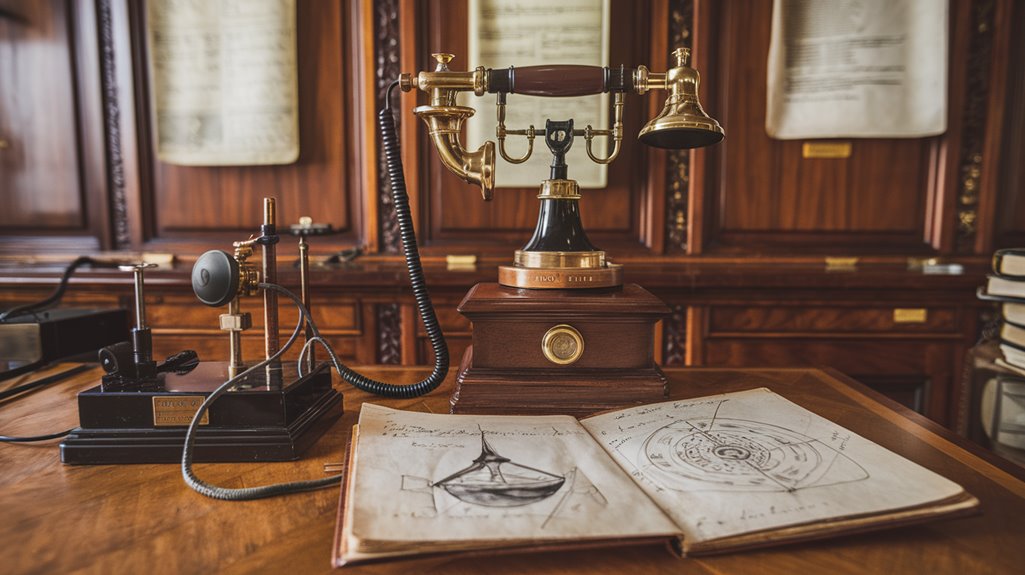
While many assume Bell's first telephone was a complex device, its core mechanism relied on surprisingly simple principles inspired by musical telegraphy.
You might be surprised to learn that the first working model used a liquid transmitter with a diaphragm and needle suspended in water, which created variable resistance when sound waves hit it.
The design worked by converting sound vibrations into electrical signals. When you'd speak into the device, the diaphragm would vibrate, causing the needle to move up and down in the water.
This movement changed the electrical resistance, creating fluctuating electrical currents that matched your voice patterns. At the receiving end, these electrical variations would transform back into sound waves, allowing the listener to hear your voice.
This breakthrough technology proved that voice transmission was possible, leading to further electromagnetic improvements. Bell demonstrated his remarkable invention at the Philadelphia Centennial Exhibition in June 1876, where it garnered significant attention.
Just moments after successfully testing the device, Bell made history when he spoke the words Mr Watson, come here to his assistant, marking the first intelligible telephone transmission.
Global Impact of Those Seven Simple Words
Those seven words spoken by Alexander Bell – "Mr. Watson, come here" – sparked a technological revolution that forever changed how we connect.
 Antonio Meucci had already pioneered early telephone concepts in the 1850s.
Antonio Meucci had already pioneered early telephone concepts in the 1850s.
When Bell uttered that first telephone message, he ignited a transformation in global communication that would reshape society, business, and culture.
By 1880, 50,000 telephone lines were already connecting Americans across the nation.
Consider these groundbreaking impacts:
- You can now instantly connect with loved ones across oceans, thanks to the first transatlantic cable in 1956
- Your business can conduct international transactions in real-time
- You're part of a world where news travels at unprecedented speed
- You've witnessed the evolution from simple voice calls to 5G networks
- Your daily life benefits from a telecommunications industry that employs millions
What started as a simple command to an assistant has evolved into a worldwide network that's fundamentally altered how you live, work, and interact with others.

